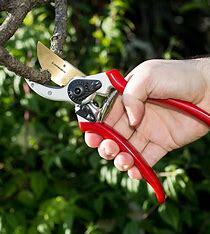Choosing the Right Pruning Tool
For pruning, the must-have tools are a pair of hand pruners, loppers, pole pruners and a saw. If you own and want to properly maintain even a single woody plant, you will eventually need all of these tools. Simple as that.
Hand pruners are meant to be used on plant material 1/2” or less in diameter. There are two types of hand pruners, bypass and anvil. On a bypass pruner the blades pass each other to make the cut. This type of pruner is good for thinning and for work on green wood. This type is the most popular. Anvil pruners work by pinching the branch being cut, like cutting a carrot on a cutting board. Anvil pruners work best on tough, dead wood.

If the material you are cutting is more than 1/2” in diameter then you need to choose a pruning saw, pole pruner or a lopper. Pruning saws can be used to cut just about anything within reach. Pole pruners are used for those out of reach branches. Pruning saws can be used to cut dense or thicker than 1 1/2” wood. Pruning saws cut on the back cut or the pull which gives you better leverage. Loppers can be used to make cuts out of arms reach or into the center of a shrub. Use this guide to determine which tool is right for your job.
- Removing buds or very new shoots: hand or knife
- Ground level, thickness up to ½”: hand pruners
- Ground level, thickness up to 1 ½”: loppers
- Ground level, up to about 4”: pruning saw
- Overhead up to about 14’, thickness up to ½”: pole pruner
- Overhead up to about 14’, thickness under 2”: Pole saw
- Overhead thickness over 2”: best to leave to a professional arborist



